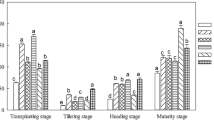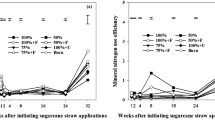Abstract
Biochar has been considered a safe soil additive to enhance soil fertility and agronomic traits of different crops. This study was conducted to explore the impacts of sugarcane waste straw biochar on soil characteristics and some agronomic traits of okra. The experiment was carried out with four treatments, i.e., control, sugarcane waste straw biochar (10 ton ha−1), farmyard manure (FYM, 10 ton ha−1), and chemical fertilizers (NPK; 120:100:80 kg ha−1) having three replications of each treatment. Soil samples were tested for texture, bulk density, particle density, pH, electrical conductivity (EC), organic matter content, nitrate nitrogen (NO3-N), and extractable-P. The sugarcane waste straw biochar was characterized for plant major nutrient elements. The impact of various treatments was observed on soils and agronomic traits of okra like plant height, fruit size, fruit length, and yield of okra. Results revealed that sugarcane waste straw biochar expressed higher EC value and noticeable amounts of nitrogen (N), phosphorus (P), potassium (K), sulfur (S), and magnesium (Mg). The sugarcane waste straw biochar, in comparison with FYM and NPK, significantly improved the NO3-N, extractable-P, OM and EC of the calcareous soil, and reduced the soil bulk density. Furthermore, plant growth and yield parameters were significantly improved under biochar application over the control, FYM and NPK. Overall, sugarcane waste straw biochar proved to be a good alternative to conventional organic and inorganic fertilizers under calcareous soil conditions.

Similar content being viewed by others
References
Abbas T, Rizwan M, Ali S, Rehman MZ, Qayyum MF, Abbas F, Hannan F, Rinklebe J, Ok YS (2017) Effect of biochar on cadmium bioavailability and uptake in wheat (Triticum aestivum L.) grown in a soil with aged contamination. Ecotoxicol Environ Saf 140:37–47
Adekayode FO, Olojugba MR (2010) The utilization of wood ash as manure to reduce the use of mineral fertilizer for improved performance of okra as measured in the chlorophyll content and grain yield. J Soil Sci Environ Manage 1:40–45
Agusalim M, Wani HU, Syechfani MS (2010) Rice husk biochar for rice based cropping system in acid soil: the characteristics of rice husk biochar and its influence on the properties of acid sulfate soils and rice growth in West Kalimantan. Ind J Agric Sci 2:39–47
Ali S, Rizwan M, Qayyum MF, Ok YS, Ibrahim M, Riaz M, Arif MS, Hafeez F, Al-Wabel MI, Shahzad AN (2017) Biochar soil amendment on alleviation of drought and salt stress in plants: a critical review. Environ Sci Pollut Res 24:12700–12712
Ameloot N, De Neve S, Jegajeevagan K, Yildiz G, Buchan D, Funkuin YN, Sleutel S (2013) Short-term CO2 and N2O emissions and microbial properties of biochar amended sandy loam soils. Soil Biol Biochem 57:401–410
Amonette J, Joseph S (2009) Characteristics of biochar micro – chemical properties. In: Lehman J, Joseph S (eds) Biochar for environmental management – science and technology. Earthscan, London, UK
Atkinson CJ, Fitzgerald JD, Hipps NA (2010) Potential mechanisms for achieving agricultural benefits from biochar application to temperate soils: a review. Plant Soil 337:1–18
Blake GR, Hartage K (1984) Bulk density and particle density. In: A. Klute (ed.). Method of soil analysis. Part 1. Physical and mineralogical method. 2nd ed. American Society of Agronomy Inc. Madism, WI, USA. pp: 363–376
Cantrell KB, Hunt PG, Uchimiya M, Novak JM, Ro KS (2012) Impact of pyrolysis temperature and manure source on physicochemical characteristics of biochar. Bioresour Technol 107:419–428
Chan KY, Zwieten LV, Meszaros IA, Downie A, Joseph S (2007) Agronomic values of green waste biochar as a soil amendment. Aus J Soil Res 45:629–634
Downie A, Crosky A, Munroe P (2009) Physical properties of biochar. Biochar for environmental management: science and technology 13–32
El-Naggar A, Lee SS, Awad YM, Yang X, Ryu C, Rizwan M, Rinklebe J, Tsang DC, Ok YS (2018) Biochar potential for carbon mineralization and improvement of infertile soils: influence of soil properties and feedstocks. Geoderma 332:100–108
Glaser B, Lehmann J, Steiner C, Nehls T, Yousaf M, Zech W (2002) Potential of pyrolyzed organic matter in soil amelioration. In 12th ISCO Conference’. Beijing (pp. 421–427)
Igalavithana AD, Mandal S, Niazi NK, Vithanage M, Parikh SJ, Mukome FN, Rizwan M, Oleszczuk P, Al-Wabel M, Bolan N, Tsang DC (2017) Advances and future directions of biochar characterization methods and applications. Crit Rev Environ Sci Technol 47:2275–2330
Kloss S, Zehetner DF, Hamid A, Ottner R, Liedtke F (2012) Characterization of slow pyrolysis biochars: effects of feedstocks and pyrolysis temperature on biochar properties. J Environ Qual 41:990–1000
Lehmann J, Gaunt J, Rondon M (2006) Bio-char sequestration in terrestrial ecosystems—a review. Mitig Adapt Strateg Glob Chang 11:395–419
Lehmann J, Rillig MC, Thies J, Masiello CA, Hockaday WC, Crowley D (2011) Biochar effects on soil biota–a review. Soil Biol Biochem 43:1812–1836
Liu XH, Zhang XC (2012) Effect of biochar on pH of alkaline soils in the loess plateau: results from incubation experiments. Int J Agric Biol 14:745–750
Malik Z, Yutong Z, ShengGao L, Abassi GH, Ali S, Kamran M, Jamil M, Al-Wabel MI, Rizwan M (2018) Effect of biochar and quicklime on growth of wheat and physicochemical properties of ultisols. Arab J Geosci 11:1–12
Nelson DW, Sommer LE (1982) Total carbon, organic carbon and organic matter. In: Pager, A. L., R. H. Hiller and D. R. Keenay (ed.) Methods of soil analysis, Part II. 2nd ed. Am Soc Agron 9:477–539
Olsen SR, Cole CV, Watanabe FS, Dean LA (1954) Estimation of available phosphorous in soil by extraction with sodium bicarbonate, USDA Circular p 939
Rehman MZ, Khalid H, Akmal F, Ali S, Rizwan M, Qayyum MF, Iqbal M, Khalid MU, Azhar M (2017) Effect of limestone, lignite and biochar applied alone and combined on cadmium uptake in wheat and rice under rotation in an effluent irrigated field. Environ Pollut 227:560–568
Rehman MZ, Rizwan M, Ali S, Fatima N, Yousaf B, Naeem A, Sabir M, Ahmad HR, Ok YS (2016) Contrasting effects of biochar, compost and farm manure on alleviation of nickel toxicity in maize (Zea mays L.) in relation to plant growth, photosynthesis and metal uptake. Ecotoxicol Environ Saf 133:218–225
Rehman MZ, Rizwan M, Ali S, Naeem A, Yousaf B, Liu G, Saifullah KH, Azhar M (2018a) A field study on the effects of phosphorus alone and combined with organic amendments on growth and cadmium accumulation in wheat and subsequent rice receiving raw effluents. Arab J Geosci 11:1–9
Rehman MZ, Rizwan M, Khalid H, Ali S, Naeem A, Yousaf B, Liu G, Sabir M, Farooq M (2018b) Farmyard manure alone and combined with immobilizing amendments reduced cadmium accumulation in wheat and rice grains grown in field irrigated with raw effluents. Chemosphere 199:468–476
Rizwan M, Ali S, Qayyum MF, Ibrahim M, Rehman MZ, Abbas T, Ok YS (2016) Mechanisms of biochar-mediated alleviation of toxicity of trace elements in plants: a critical review. Environ Sci Pollut Res 23:2230–2248
Ryan J, Estefan G, Rashid A (2001) Soil and plant analysis. Laboratory manual. International Centre for Agriculture Research in the dry areas, Aleppo, Syria
Schulz H, Bruno G (2012) Effects of biochar compared to organic and inorganic fertilizers on soil quality and plant growth in a greenhouse experiment. J Plant Nutr Soil Sci 175:410–422
Shaheen SM, Rinklebe J (2015) Impact of emerging and low cost alternative amendments on the (im) mobilization and phytoavailability of Cd and Pb in a contaminated floodplain soil. Ecol Eng 74:319–326
Siemonsma JS (1982) The cultivation of okra (Abelmoschus spp.), [tropical fruit]-vegetable (with special reference to the Ivory coast). D.H.O, thesis Wageningen Agricultural Wageningen, The Netherland, p 297
Sims JR, Jackson GGD (1971) Rapid analysis of soil nitrate with chromotropic acid. Soil Sci Soc Am Proc 35:603–606
Steel RGD, Torrie JH, Discky DA (1997) Principles and procedures of statistics: a biometrical approach, 3rd (ed.) edn. McGraw Hill Book Co, New York, USA
Steiner C, Teixeira WG, Lehmann J, Nehls T, Vasconcelos de Macedo JL, Blum WEH, Zech W (2007) Long term effects of manure, charcoal and mineral fertilization on crop production and fertility on a highly weathered central Amazonian upland soil. Plant Soil 291:275–290
Ueckert DN, Whigham TL, Spears BM (1978) Effect of burning on infiltration, sediment, and other soil properties in a mesquite: tobosagrass community. J Range Manage 1:420–425
Verheijen F, Jeffery S, Bastos AC, van der Velde M, Diafas I (2009) Biochar application to soils, a critical scientific review of effects on soil properties, processes and functions (Office for the Official Publ. of the European Communities, Luxembourg, 2009)
William K, Qureshi RA (2015) Evaluation of biochar as fertilizer for the growth of some seasonal vegetables. J Biores Manage 2:41–46
Acknowledgements
The authors specially thanks Professor Dr. Zhu Shuijin and Li from Zhejiang University, Hangzhou, China for their help in the scanning electron microscopy.
Funding
This study was funded by the Higher Education Commission of Pakistan, Startup Research Grant, project No. 393.
Author information
Authors and Affiliations
Corresponding author
Additional information
This article is part of the Topical Collection on Implications of Biochar Application to Soil Environment under Arid Conditions
Rights and permissions
About this article
Cite this article
Riaz, M., Khan, M., Ali, S. et al. Sugarcane waste straw biochar and its effects on calcareous soil and agronomic traits of okra. Arab J Geosci 11, 752 (2018). https://doi.org/10.1007/s12517-018-4113-2
Received:
Accepted:
Published:
DOI: https://doi.org/10.1007/s12517-018-4113-2




